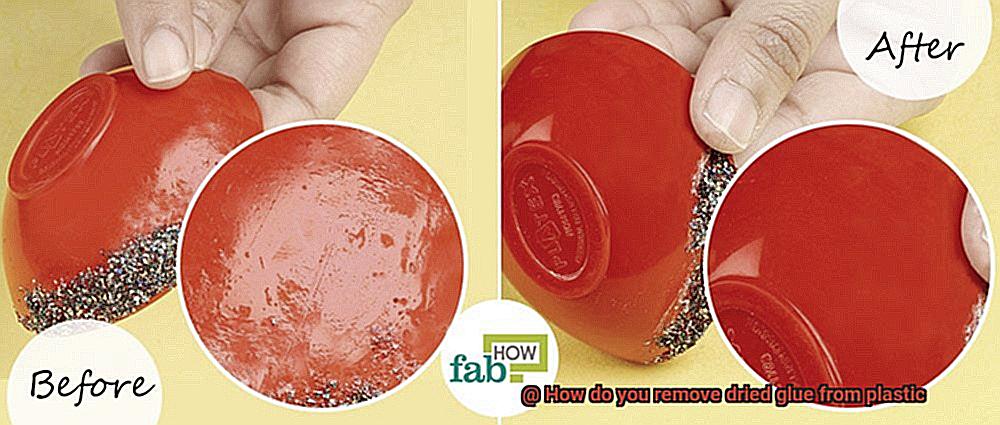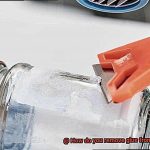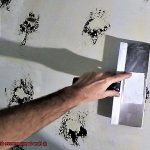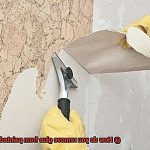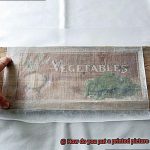Picture this: you excitedly unwrap a package, only to discover that stubborn glue has decided to make your new plastic item its permanent home. Whether it’s from a pesky price tag, a crafting catastrophe, or a not-so-successful repair job, dried glue on plastic is enough to make anyone’s blood boil. But fret not. We’ve got your back with the most effective techniques to bid farewell to this unwelcome residue.
In this all-inclusive guide, we’ll dive into the nitty-gritty of glue adhesion, explore different types of glues and plastics, and arm you with genius yet straightforward methods to efficiently remove dried glue from plastic surfaces. Get ready as we spill the secrets that will bring your beloved possessions back to their pristine condition and give them a fresh lease on life.
So, let’s get down and dirty as we embark on an epic journey of banishing sticky situations and restoring your plastic items’ former glory.
What is Dried Glue?
Contents
- 1 What is Dried Glue?
- 2 Types of Glue Used on Plastic
- 3 Removing Dried Glue with Rubbing Alcohol or Acetone
- 4 Removing Dried Glue with Warm Soapy Water
- 5 Using a Plastic Scraper or Credit Card to Remove Dried Glue
- 6 Using Heat to Remove Dried Glue from Plastic
- 7 Commercial Adhesive Removers for Removing Dried Glue from Plastic
- 8 Safety Tips When Removing Dried Glue from Plastic
- 9 Conclusion
That stubborn, rock-hard residue that clings to plastic surfaces like an unwelcome guest. But fear not, for in this article, we delve into the captivating world of dried glue to understand its properties and reveal effective methods for its removal.
Understanding Dried Glue:
Dried glue is the result of an intriguing chemical reaction known as polymerization. When glue comes into contact with air or moisture, it undergoes a transformation, solidifying into a hardened state. Different types of glue, such as white glue, super glue, epoxy glue, and hot glue, have varying drying times and unique properties.
The Challenges of Removing Dried Glue:
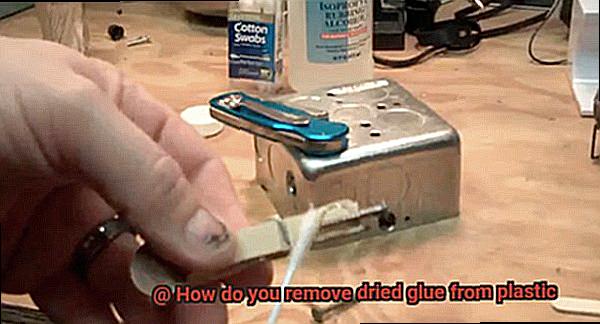
Removing dried glue from plastic surfaces can be an arduous task. Its tenacious grip on the plastic makes it resistant to simple cleaning methods. Some glues even contain additives or chemicals that enhance their adhesive properties, making them even more challenging to remove.
Effective Methods for Removing Dried Glue from Plastic:
Rubbing Alcohol or Acetone:
Moisten a cloth or cotton ball with rubbing alcohol or acetone. Gently rub the cloth onto the dried glue, allowing the solvent to dissolve and loosen the adhesive. Repeat as needed until the glue starts to surrender.
Warm Soapy Water:
Fill a bowl with warm water and add a few drops of dish soap. Immerse the affected area in the soapy water, letting it soak to weaken the grip of the glue. Use a soft brush or sponge to gently scrub away the residue. Rinse thoroughly to banish any soap remnants.
Plastic Scraper or Credit Card:
Hold a plastic scraper or credit card at a low angle and carefully scrape along the edge of the dried glue. Gradually lift it off the plastic surface, exerting just enough pressure to avoid scratches.
Heat Method:
Employ a hairdryer on a low heat setting to warm up the glue. As it softens, wipe it away with a clean cloth or paper towel, bidding farewell to its stubborn hold.
Commercial Adhesive Removers:
Harness the power of commercial adhesive removers specially formulated for tackling tough glue residues. Follow the manufacturer’s instructions meticulously for optimal results.
Types of Glue Used on Plastic
When it comes to bonding plastic, the right glue can work wonders. But with an array of options available, it’s crucial to understand the characteristics of each type. In this post, we’ll delve into the various types of glue used on plastic and their unique properties. Additionally, we’ll offer tips for removing dried glue from plastic surfaces.
Types of Glue for Plastic:
Super Glue (Cyanoacrylate Adhesive):
Super glue is a fast-drying adhesive that forms an instant and strong bond. It is ideal for small repairs or bonding small plastic parts together. However, caution is necessary as it can be challenging to remove once dried.
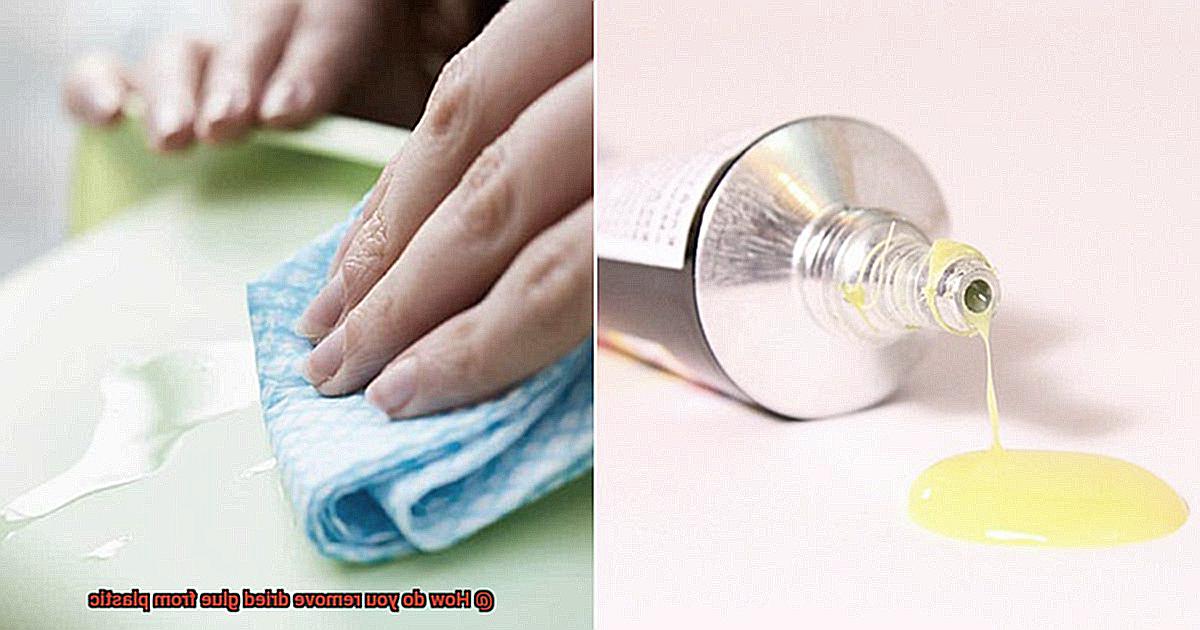
Epoxy Adhesive:
Consisting of two parts—a resin and a hardener—epoxy adhesive creates a durable bond, making it suitable for larger repairs or bonding plastic pieces exposed to heavy loads or harsh conditions. To remove dried epoxy from plastic, gentle heating and scraping are effective methods.
Polyurethane Adhesive:
Polyurethane adhesive offers flexibility and moisture resistance, making it perfect for bonding plastic parts that experience changing temperatures or high humidity. Removing dried polyurethane glue may require mechanical means and solvents.
Silicone Adhesive:
Silicone adhesive forms a flexible and durable bond, making it ideal for applications requiring movement or vibrations. When needed, silicone adhesive can be softened with heat and scraped off.
Choosing the Right Glue:
To select the appropriate glue, consider the specific application and type of plastic being bonded. Different glues have varying strengths, flexibility, and resistance properties. Following the manufacturer’s instructions is vital for achieving optimal results.
Removing Dried Glue from Plastic:
Rubbing Alcohol or Acetone:
Moisten a cloth or cotton ball with rubbing alcohol or acetone and gently rub onto the glue. Repeat until the glue loosens and comes off.
Warm Soapy Water:
Soak the affected area in warm, soapy water, then gently scrub with a soft brush or sponge to remove the glue.
Plastic Scraper or Credit Card:
Gently scrape along the edge of the dried glue to lift it off the plastic surface using a plastic scraper or credit card.
Heat:
Use a hairdryer on low heat to soften the glue, then wipe it away with a cloth or paper towel.
Removing Dried Glue with Rubbing Alcohol or Acetone
Removing dried glue from plastic surfaces can be a frustrating task, but with the right techniques and solvents, it can be made much easier. Rubbing alcohol and acetone are two commonly used solvents that can effectively break down and dissolve glue bonds. However, it’s important to note that not all plastics are created equal, and some may be more sensitive to these solvents.
To ensure success and avoid any potential damage or discoloration, it’s recommended to test the solvent on a small, inconspicuous area of the plastic surface first.
To remove dried glue with rubbing alcohol, start by soaking a clean cloth or cotton ball with the alcohol. Gently rub the affected area, allowing the alcohol to sit for a few minutes to soften the glue.
Then, using a plastic scraper or your fingernail, carefully scrape away the softened residue. Repeat this process as necessary until all the glue is removed.
If you prefer to use acetone, follow similar steps. Soak a cloth or cotton ball with acetone and apply it to the glued area. Let it sit for a few minutes to soften the adhesive before scraping away the residue with a plastic scraper or your fingernail.
Remember to exercise caution when using acetone, as it is a strong chemical that can potentially damage certain plastics. Work in a well-ventilated area and avoid prolonged exposure.
Both rubbing alcohol and acetone can effectively remove different types of glue, including super glue, epoxy, and craft glues. However, some adhesives may require additional steps or alternative solvents for complete removal.
After successfully removing the dried glue, it’s crucial to clean the plastic surface thoroughly with soap and water to remove any residue from the solvents. This will help restore the original appearance of the plastic and prevent any potential damage caused by prolonged exposure to the solvents.
Removing Dried Glue with Warm Soapy Water
Glue can be a lifesaver for arts and crafts, repairs, and DIY projects. But when that adhesive dries and sticks to plastic surfaces, it can be a sticky situation. Fortunately, warm soapy water is here to save the day. In this comprehensive guide, we will explore the magical powers of warm soapy water and how it effortlessly removes dried glue from plastic surfaces.
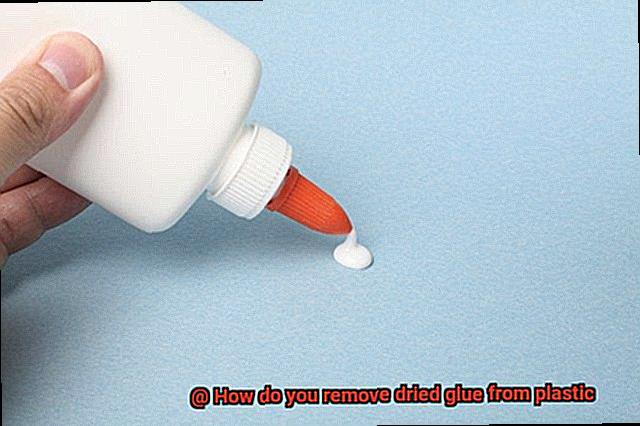
Step-by-Step Guide:
Prepare the Solution:
Gather a container and create a solution by mixing mild dish soap with warm water. The ratio may vary based on glue strength and affected area size.
Check Water Resistance:
Before starting, ensure your plastic surface is water-resistant. Prolonged exposure to water can damage or discolor some plastics.
Soak and Dab:
Once your plastic surface is safe, soak a clean cloth or sponge in the warm soapy water solution. Gently dab the cloth onto the dried glue, allowing the solution to penetrate for a few minutes.
Gentle Scrubbing:
Break down the adhesive properties of the glue by using a soft-bristled brush or an old toothbrush. Employ circular motions with light pressure to avoid scratching the plastic.
Loosen and Break Apart:
Continue scrubbing until you see the dried glue loosening and breaking apart. Apply more warm soapy water if needed.
Rinse:
After successfully removing the glue, rinse the plastic surface with clean water to eliminate any soap residue.
Dry Thoroughly:
Dry the plastic surface using a clean towel or let it air dry completely.
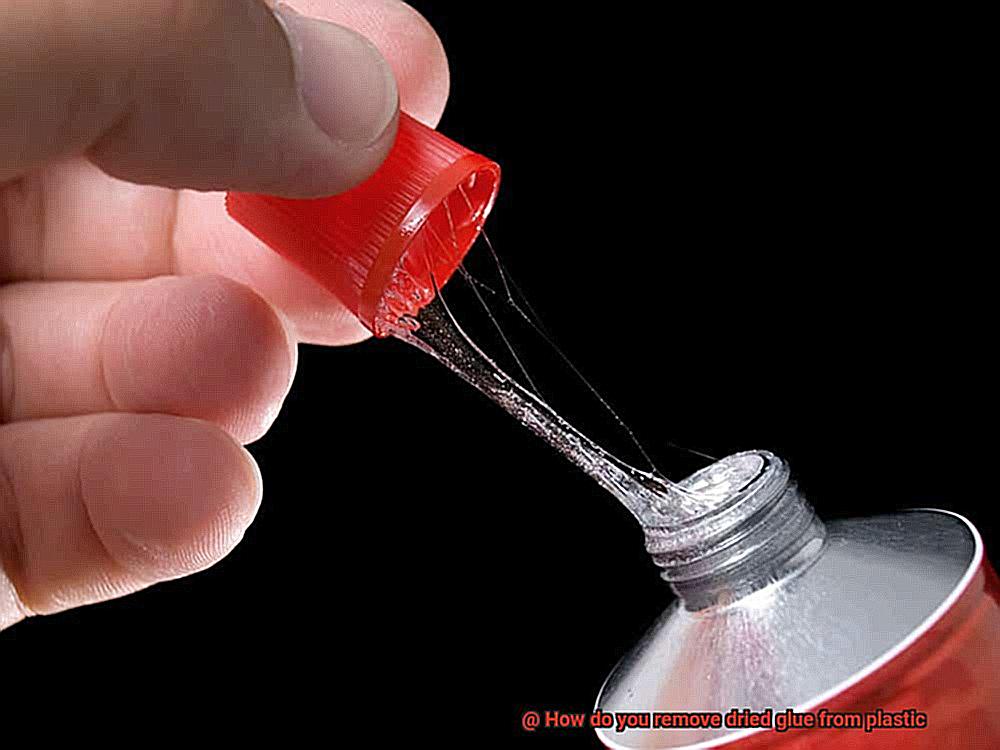
Additional Tips:
- For tougher glue stains, add a small amount of vinegar to the warm soapy water solution.
- Always test the solution on a small, inconspicuous area before proceeding.
- Patience is key. Removing glue may take time and multiple attempts, depending on its type and age.
Using a Plastic Scraper or Credit Card to Remove Dried Glue
Removing dried glue from plastic surfaces can be a challenging task, but fear not. With the right tools and techniques, you can achieve success. One of the most effective methods is using a plastic scraper or credit card.
These tools are gentle yet effective at removing dried glue without causing any damage to the plastic surface. Here’s a step-by-step guide on how to use them:
- Ensure the glue is completely dry: Before you begin, make sure that the glue is fully set and hardened. This will prevent any messy surprises during the removal process.
- Choose the right tool: Opt for a plastic scraper or credit card instead of metal tools. Metal tools can be too aggressive and may potentially scratch or damage the plastic surface.
- Start scraping: Begin by gently scraping the edge of the dried glue with your plastic tool. Apply light pressure and work in small, controlled motions. Imagine peeling off a layer of adhesive armor from your plastic surface. If necessary, gradually increase the pressure, but be cautious not to apply too much force that could cause the plastic to crack or break.
- Use heat for stubborn glue: For particularly stubborn glues that refuse to budge, employ heat as a secret weapon. Grab a hairdryer and set it on low heat. Gently warm up the glue, making it softer and more pliable for easier removal.
- Be patient: Removing dried glue may require multiple passes, so be patient and persistent in your efforts. Continue scraping away until every last trace of glue has been vanquished.
- Clean the surface: Once you’ve successfully defeated the dried glue, it’s time to clean the plastic surface. Use warm soapy water or a mild cleaning solution to remove any remaining residue. Rinse thoroughly and dry with a clean cloth to ensure no moisture is left behind.
Using Heat to Remove Dried Glue from Plastic
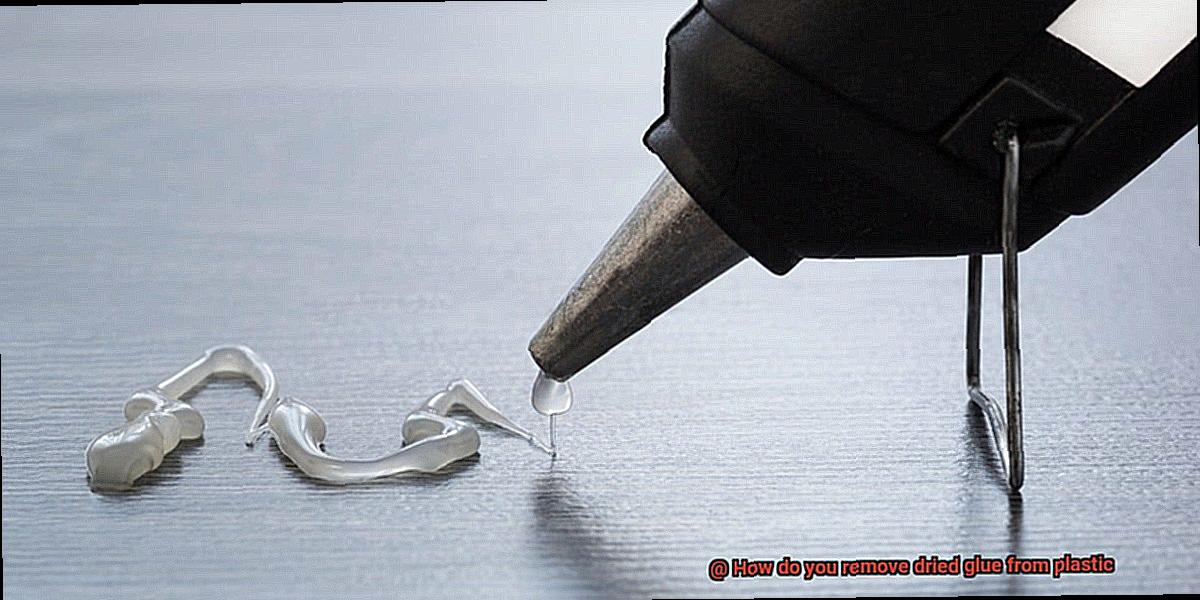
Dried glue clinging stubbornly to plastic surfaces can be a headache-inducing challenge. But fret not, courageous warriors. Help is at hand in the form of a secret weapon – heat. In this article, we shall delve into the magical world of using heat to effectively bid farewell to dried glue on plastic surfaces. So grab your trusty plastic scraper or credit card and embark on this adhesive adventure with us.
Gather Your Tools:
- Hairdryer or heat gun: Select a device that offers low to medium heat options.
- Plastic scraper or credit card: These will serve as your trusty companions in the battle against dried glue.
- Damp cloth: Keep it handy for wiping away residue.
Prepare for Battle:
- Set your hairdryer or heat gun: Ensure it is on low to medium heat setting.
- Maintain distance: Hold the device approximately 6 inches away from the dried glue.
Apply Heat:
- Even heating: Move the hairdryer or heat gun back and forth over the glue, distributing heat evenly.
- Softening magic: As the glue heats up, it will soften, becoming more malleable and easier to remove.

Gentle Peeling:
- Delicate strokes: Employ your plastic scraper or credit card to gently scrape off the softened glue.
- Protect the surface: Exercise caution to avoid scratching or damaging the plastic surface.
Conquer Stubborn Glue:
- Increase the heat: If stubborn traces of glue remain, slightly increase the heat to further soften them.
- Proceed with care: Be mindful of excessive heat that could potentially melt or warp certain types of plastic.
Wipe Away Residue:
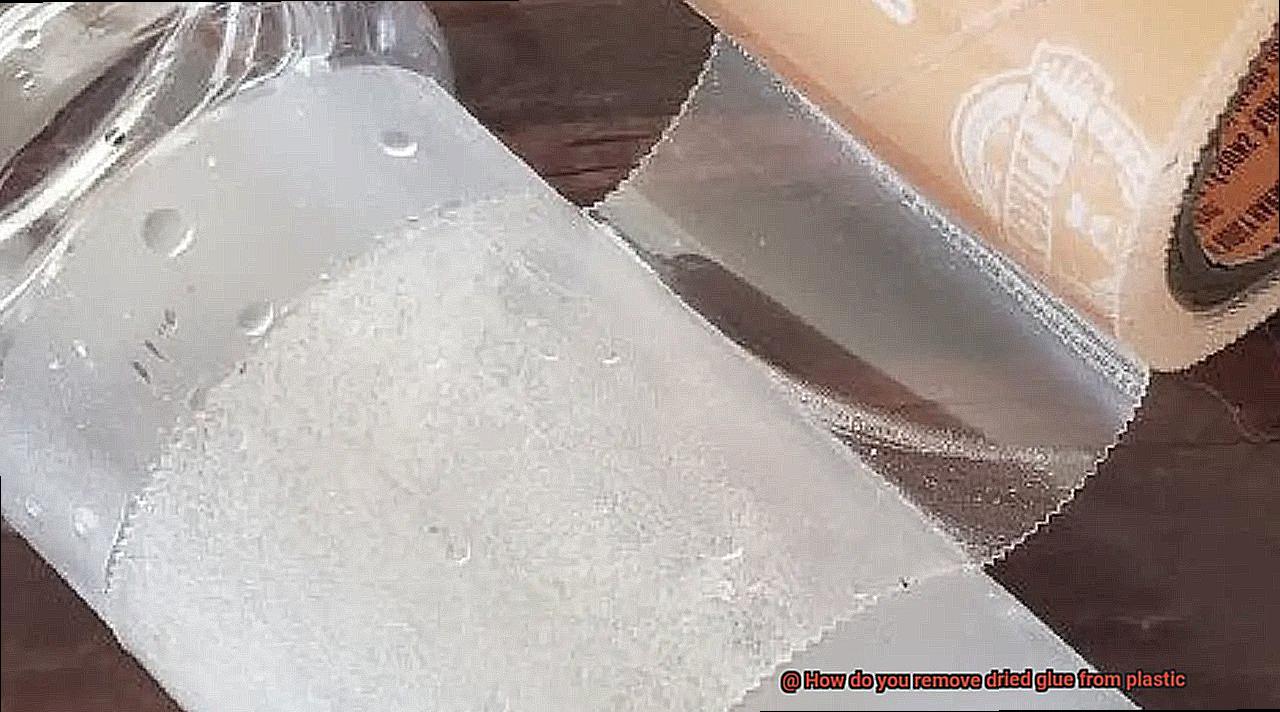
The final touch: Once you have scraped off as much glue as possible, use a damp cloth to wipe the area, eliminating any remaining residue.
Repeat if Necessary:
Thicker layers or larger areas: In the face of more formidable adhesive challenges, repeat the process until every last bit of glue is removed.
Cleanse and Restore:
The finishing flourish: To restore the plastic surface’s former glory, thoroughly clean it using warm soapy water or a mild cleaning solution.
Commercial Adhesive Removers for Removing Dried Glue from Plastic
We’ve all experienced that frustrating moment when a glob of glue ends up on our beloved plastic item, leaving behind an unsightly mess. But fret not. With the assistance of commercial adhesive removers, you can effortlessly bid farewell to dried glue and restore your plastic surfaces to their former glory. In this comprehensive guide, we will walk you through the simple steps of using these magical solutions, accompanied by valuable tips and clever tricks for successful glue removal.
Step-by-Step Instructions:
Choose the right adhesive remover:
- Acetone: A potent and efficient option, but exercise caution as it may damage certain plastics. Test it on a small area first.
- Citrus-based solvents: Gentler and suitable for more delicate plastics.
Prepare your tools:
- Clean cloth or cotton ball
- Plastic scraper or credit card
- Damp cloth for residue removal
Apply the adhesive remover:
- Acetone: Apply a small amount to the cloth or cotton ball.
- Citrus-based solvents: Follow the product instructions for application.
Gently rub or dab:
- Employ the cloth or cotton ball to gently rub or dab the adhesive remover onto the dried glue.
- Allow a few minutes for the solution to penetrate and dissolve the adhesive.
Wipe away dissolved glue:
- Use a clean cloth to wipe away the dissolved glue.
- For stubborn spots, gently scrape at an angle with a plastic scraper or credit card to avoid scratching the plastic surface.
Repeat if necessary:
- If any residue remains, repeat steps 3-5 until all traces of glue are removed.
Clean and dry:
- Wipe the plastic surface with a damp cloth to eliminate any adhesive remover residue.
- Thoroughly dry the surface.
Tips and Additional Information:
- Always test the adhesive remover on a small, inconspicuous area of the plastic surface before applying it to the entire area.
- Follow the manufacturer’s instructions for application methods, safety precautions, and recommended usage.
- For stubborn glue, use heat as a pre-treatment by gently heating it with a hairdryer or heat gun before applying the adhesive remover.
- When dealing with a large area of dried glue, consider using a spray adhesive remover for easier and more even application.
Safety Tips When Removing Dried Glue from Plastic
Removing dried glue from plastic surfaces requires caution to protect yourself and prevent damage to the plastic. This article presents eight safety tips to follow when removing dried glue from plastic. By adhering to these precautions, you can ensure a safe and successful glue removal process while safeguarding your well-being and the integrity of the plastic.
Prioritize Personal Safety:
Before starting the glue removal process, wear protective gloves, such as latex or nitrile gloves, to shield your hands from potential skin irritations or chemical burns. Additionally, safeguard your eyes by wearing safety goggles to prevent splashes or accidental contact with chemicals.
Work in a Well-Ventilated Area:
Ensure that you work in a well-ventilated space, preferably outdoors or in a room with open windows, to minimize exposure to potentially harmful fumes. Adequate ventilation helps maintain clean air quality and protects you from inhaling any dangerous chemicals.
Follow Instructions:
Different glue removers have specific instructions and safety precautions. Before using any product, carefully read and follow the instructions provided by the manufacturer. This will ensure that you use the product correctly and minimize any risks associated with its use.
Test in an Inconspicuous Area:
Before applying any glue remover to the entire plastic surface, test it in a small, inconspicuous area first. This will help you determine if the product causes any adverse reactions or damage to the plastic material. If there are no negative effects after a few minutes, proceed with confidence.
Use Gentle Techniques:
When removing dried glue from plastic, avoid using excessive force or pressure. Applying too much force can result in scratches, cracks, or even breakage of the plastic surface. Instead, opt for gentle rubbing or scraping techniques to gradually loosen and remove the dried glue without causing damage.
Select Appropriate Tools:
Choose the right tools for safe glue removal. Plastic scrapers, credit cards, or soft-bristled toothbrushes can be useful in gently removing dried glue without causing damage. Ensure that the tools you use are appropriate for the specific plastic material you are working with.
Protect Adjacent Surfaces:
To prevent damage to surrounding areas, cover adjacent surfaces with masking tape or a protective barrier. This will safeguard sensitive surfaces from scratches or accidental contact with glue removers.

Dispose of Chemicals Properly:
After successfully removing the dried glue, dispose of any chemicals or solvents used during the process according to local regulations. Proper disposal helps protect the environment and prevents potential hazards.
8QNGGQ7nvv0″ >
Also Read: How To Remove Glue On Plastic Container?
Conclusion
Removing dried glue from plastic can be a frustrating task, but fear not, for there are effective methods to tackle this sticky situation.
One approach is to use a simple household item – vinegar. Soak a cloth in vinegar and gently rub the dried glue, allowing the acid in the vinegar to break down the adhesive.
Another option is to employ the power of heat. Grab a hairdryer and direct its warm airflow onto the glued area.
As the heat softens the glue, carefully scrape it off with a plastic scraper or your fingernail. For more stubborn glue, try using rubbing alcohol or nail polish remover containing acetone.
Remember to test these substances on a small, inconspicuous area first to ensure they do not cause any discoloration or damage.

